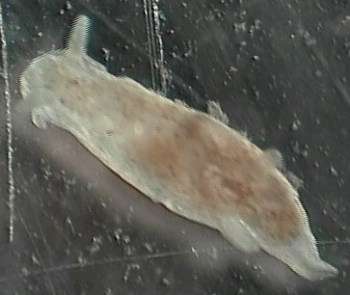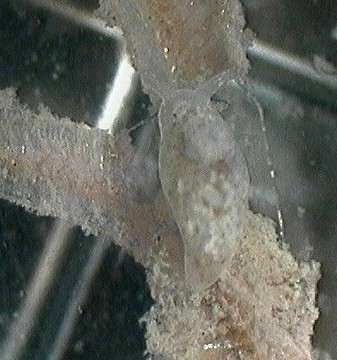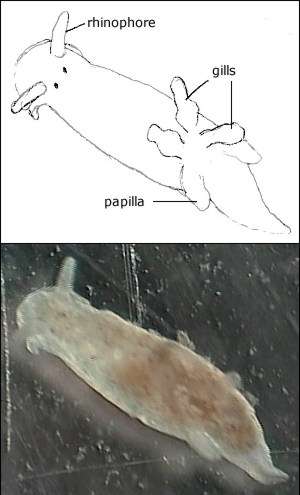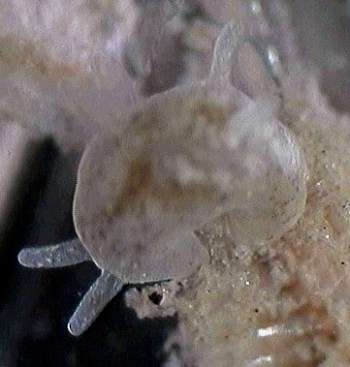
Polycerella emertoni
Verrill, 1880
Order: NUDIBRANCHIA
Suborder: DORIDINA
Superfamily: ANADORIDOIDEA
Family: Polyceridae
Subfamily: Polycerinae
DISTRIBUTION
Atlantic coast of America from Massachusetts, USA to Sao Paulo, Brazil. Also Mediterranean, southern Spain.
PHOTO
Mississippi Sound, USA., on Bugula neritina. PHOTO: Eric Pederson.
Grows to a maximum of 5mm. reported to feed on arborescent bryozoans such as Zoobotryon sp., Bowerbankia gracilis, Amathia distans and reported below on Bugula neritina.
See messages below.
References:
•Behrens, D.W. & Gosliner,T. M. (1988) The first record of Polycerella verrilli, 1881, from the Pacific, with the description of a new species. The Veliger 30(3): 319-324.[ Polycerella glandulosa]
•Garcia, J.C. & Bobo, A. (1986) Un nuevo doridaceo para el litoral Iberico: Polycerella emertoni Verrill (1880) 1881 (Gastropoda: Nudibranchia). Bolletino Malacologico, 22(1-4): 49-56.
•Franz, D.R. & Clark, K.B. (1972) A discussion of the systematics, reproductive biology and zoogeography of Polycerella emertoni and related species. (Gastropoda: Nudibranchia). The Veliger, 14: 265-268.
•Marcus, Er. (1957) On Opisthobranchia from Brazil (2). Journal of the Linnean Society of London, Zoology 43(292) : 390-486. [Polycerella conya]
•Marcus, E. & Marcus, Er. (1960) Opisthobranchs from American Atlantic warm waters. Bulletin of Marine Science of the Gulf and Caribbean, 10(2) : 129-203. [Polycerella conya]
•Marcus, E. (1976) Marine euthyneuran gastropods from Brazil (3). Studies of the Neotropical Fauna and Environment, 11: 5 - 23. [P. conya = P. recondita = P. emertoni]
•Verrill, A.E. (1880) Notice of recent additions to the marine invertebrata, of the northeastern coast of America, with descriptions of new genera and species and critical remarks of others. Part II. Mollusca, with notes on Annelida, Echinodermata, etc., collected by the United States Fish Commission. Proceedings of the United States National Museum, 22:, 381-393, 356-360. [Polycerella emertoni]
Rudman, W.B., 2000 (January 25) Polycerella emertoni Verrill, 1880. [In] Sea Slug Forum. Australian Museum, Sydney. Available from http://www.seaslugforum.net/find/polyemer
Related messages
Re: Polycerella emertoni
February 23, 2000
From: Eric Pederson
Dr. Rudman,
Thank you for your assistance in the identification of the sea slug. I have just received a reply from someone else I sent the photos to who agrees with you on the genus, but has named it Polycerella conyna Marcus, 1957. Some figures can be found in Bull Mar Sci 10(2):159. Let me know what you think.
Thanks again,
Eric
epederso@ocean.otr.usm.edu
Pederson, E., 2000 (Feb 23) Re: Polycerella emertoni. [Message in] Sea Slug Forum. Australian Museum, Sydney. Available from http://www.seaslugforum.net/find/1942Dear Eric,
I should have mentioned there are a number of names floating in the literature for what is generally considered to be one species. Franz & Clark (1972) studied a large population and considered the variation within that population covered the so-called differences between P. conya (originally described from Brazil) and P. emertoni. Marcus (1976) re-examined material from Brazil and P. recondita Schmekel, 1965 from the Mediterranean and agreed that they are all conspecific, the earliest name being P. emertoni.
I don't know of a later study contradicting that view. I am sorry I didn't think of mentioning Franz & Clark's paper as it has some basic biological information which would be of interest to you.
I have added a list of references at the top of the page in case anyone wishes to follow this up.
Best wishes,
Bill Rudman.
Another photo of Polycerella
February 18, 2000
From: Eric Pederson

Bill,
This is the last picture that I have of this critter. I hope it helps.
Also, you mentioned that currently, there is no common name for this slug. I was thinking that since the locals call the bryozoans "sauerkraut", that an appropriate name would be something on the order of "sauerkraut slug" or "kraut nudibranch".
Thanks for all your help,
Eric
eric.pederson@usm.edu
Pederson, E., 2000 (Feb 18) Another photo of Polycerella. [Message in] Sea Slug Forum. Australian Museum, Sydney. Available from http://www.seaslugforum.net/find/1920
Dear Eric,
I am pretty sure it is Polycerella. I have been meaning to post the rough sketch I sent you of my interpretation of your second photo so I have done so here with the photo.
I don't think there's much doubt about its identity even though I have never seen it alive or a photo of it.
Concerning a common name I guess 'Emerton's polycerid' would be my suggestion if you must have one.
Best wishes,
Bill Rudman.
Mystery animal is Polycerella emertoni?
January 25, 2000
From: Eric Pederson

Greetings,
Here is a second picture of what I presume to be a nudibranch found on the bryozoan Bugula neritina.
Thanks for your consideration,
Eric
eric.pederson@usm.edu
Pederson, E., 2000 (Jan 25) Mystery animal is Polycerella emertoni?. [Message in] Sea Slug Forum. Australian Museum, Sydney. Available from http://www.seaslugforum.net/find/1771Dear Eric,
Your second picture is definitely not of a leptonid bivalve, as I tentatively suggested from your first photo.
I am pretty sure that it is Polycerella emertoni which has a pair of smooth anterior rhinophores, 3 relatively large gills, and a pair of relatively large smooth papillae just behind the gills. It has some other smaller papillae but I can't see these in your photos. It feeds on bryozoans.
If I'm wrong I am sure someone will let us know.
Best wishes,
Bill Rudman.
Nudibranchs? on Bryozoan
January 5, 2000
From: Eric Pederson

Hello,
I am a graduate student at the Gulf Coast Research Lab in Ocean Springs, Mississippi. I am studying the ecology of the organisms found on bryozoans that accrue here in the fall. I have found many nudibranchs on the bryozoans and have not been able to I.D. them. They have been found on two species of bryozoa- Bugula neritina and Zoobotrium verticulatum. The nudibranchs are found in the Mississippi Sound which is an estuary, but we do not know where the bryozoans originate - no one has yet found them in their sessile form in this area. When I collect them, they have floated/drifted in in large mats. I hope this information and included pictures make I.D. of these critters possible. The ones in these pictures were found on Bugula neritina.
Thank you for your consideration,
Eric
eric.pederson@usm.edu
Pederson, E., 2000 (Jan 5) Nudibranchs? on Bryozoan. [Message in] Sea Slug Forum. Australian Museum, Sydney. Available from http://www.seaslugforum.net/find/1728Dear Eric,
If this is a sea slug, I think I will need some more photos to check out its shape. When I saw your message I immediately thought of Okenia zoobotryon. What your photo does remind me of are bivalves of the family Leptonidae ( and related families) which are small and quite often crawl along like snails and have long papillae (sometimes coloured) extending out from the mantle flaps which partially cover their shells. However I don't know of any associated with bryozoans.
Any ideas from others are welcome. Eric, if you have photos of other slugs from bryozoans they would be very welcome.
Best wishes,
Bill Rudman
